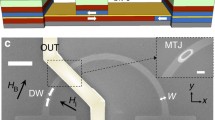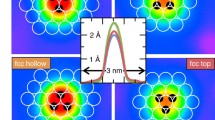Abstract
We propose a ballistic magneto-electric device that permits conductance modulation with both electric and magnetic fields applied perpendicular to its current conduction channel. Fields are applied through the ferromagnetic gates deposited on top of a HEMT heterostructure that contains a 2DEG for current conduction. The minimal-coupling Hamiltonian with spatially uniform electrical potentials, and delta Zeeman splitting is solved in the weak-coupling limit for which the Rashba spin orbit coupling is not considered. Ballistic transmission of electrons through a periodic system of zero-gauge double-pair magnetoelectric barriers is studied. Manipulation of barriers’ geometrical symmetry and configuration leads to the conception of a spin-FET for non-volatile storage and digital logic operations. The linear modulation of electron spin polarization (|P|) is also studied for its relevance to electrical signal amplification. Perpendicular magnetization of the ferromagnetic gates permits modulation of both |P| and electron transmission (T) threshold, the latter is particularly useful for spin logic design.








Similar content being viewed by others
References
A. Matulis, F. M. Peeters, and P. Vasilopoulos, Phys. Rev. Lett. 72, 1518 (1994).
G. Papp and F. M. Peeters, Appl. Phys. Lett. 78, 2184 (2001).
A. Majumdar, Phys. Rev. B 54, 11911 (1996).
Y. Jiang, M. B. A. Jalil, and T. S. Low, Appl. Phys. Lett. 80, 1673 (2002).
H. Z. Xu and Y. Okada, Appl. Phys. Lett. 79, 3119 (2001).
Y. Guo, J.-H. Qin, X.-Y. Chen, and B.-L. Gu, Semicond. Sci. Technol. 18, 297–299 (2003).
Y. Guo, B. Gu, W. Duan, and Y. Zhang, Phys. Rev. B 55, 9314 (1997).
V. Umansky, R. de-Picciotto, and M. Heiblum, Appl. Phys. Lett. 71, 683 (1997).
M. I. D’yakonov and V. I. Perel’, Zh. Eksp. Teor. Fiz. 60, 1954 (1971) [Sov. Phys. JETP 33, 1053 (1971)].
F. X. Bronold, I. Martin, A. Saxena, and D. L. Smith, Phys. Rev. B 66, 233206 (2002).
G. Dresselhaus, Phys. Rev. 100, 580 (1955).
M. B. A. Jalil, S. G. Tan, T. Liew, K. L. Teo, and T. C. Chong, J. Appl. Phys. 95, 7321 (2004).
S. Datta and B. Das, Appl. Phys. Lett. 56(7), 665 (1989).
Acknowledgments
We would like to thank the agency for Science, Technology, and Research (A*STAR) of Singapore for financially supporting the work under Grant No. 022 105 0053.
Author information
Authors and Affiliations
Rights and permissions
About this article
Cite this article
Tan, S.G., Jalil, M.B.A., Liew, T. et al. Magnetoelectric Spin-FET for Memory, Logic, and Amplifier Applications. J Supercond 18, 357–365 (2005). https://doi.org/10.1007/s10948-005-0010-5
Received:
Accepted:
Published:
Issue Date:
DOI: https://doi.org/10.1007/s10948-005-0010-5




